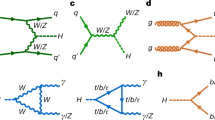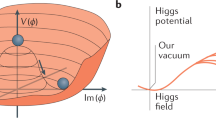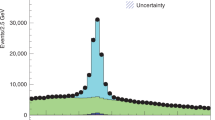Abstract
As a mediator of the weak nuclear force, the W boson influences many properties of fundamental particles and their interactions. Understanding the W boson as accurately as possible, including knowing its mass, has been a priority in particle physics for decades. In the past few years, in a succession of increasing-precision measurements by multiple experiments, a significant tension between the measured and predicted mass has been documented by the CDF Collaboration. Furthermore, smaller differences between different measurements exist. Because the W boson mass provides a window on new physics, a comparison between different measurement techniques can inform the path to further investigations. This Perspective article overviews the role of the W boson mass in the Standard Model of Particle Physics and its extensions, compares and contrasts its measurement techniques and discusses prospects and future directions.
This is a preview of subscription content, access via your institution
Access options
Access Nature and 54 other Nature Portfolio journals
Get Nature+, our best-value online-access subscription
$29.99 / 30 days
cancel any time
Subscribe to this journal
Receive 12 digital issues and online access to articles
$99.00 per year
only $8.25 per issue
Buy this article
- Purchase on Springer Link
- Instant access to full article PDF
Prices may be subject to local taxes which are calculated during checkout


Similar content being viewed by others
References
Wu, C. S., Ambler, E., Hayward, R. W., Hoppes, D. D. & Hudson, R. P. Experimental test of parity conservation in beta decay. Phys. Rev. 105, 1413–1415 (1957).
Anderson, P. W. Plasmons, gauge invariance, and mass. Phys. Rev. 130, 439 (1963).
Englert, F. & Brout, R. Broken symmetry and the mass of gauge vector mesons. Phys. Rev. Lett. 13, 321 (1964).
Higgs, P. W. Broken symmetries and the masses of gauge bosons. Phys. Rev. Lett. 13, 508–509 (1964).
Higgs, P. W. Broken symmetries, massless particles and gauge fields. Phys. Lett. 12, 132–133 (1964).
Guralnik, G. S., Hagen, C. R. & Kibble, T. W. B. Global conservation laws and massless particles. Phys. Rev. Lett. 13, 585 (1964).
Aad, G. et al. Observation of a new particle in the search for the Standard Model Higgs boson with the ATLAS detector at the LHC. Phys. Lett. B 716, 1 (2012).
Chatrchyan, S. et al. Observation of a new boson at a mass of 125 GeV with the CMS experiment at the LHC. Phys. Lett. B 716, 30 (2012).
Glashow, S. Partial-symmetries of weak interactions. Nucl. Phys. 22, 579 (1961).
Salam, A. & Ward, J. C. Electromagnetic and weak interactions. Phys. Lett. 13, 168 (1964).
Weinberg, S. A model of leptons. Phys. Rev. Lett. 19, 1264 (1967).
Salam, G. P., Wang, L. T. & Zanderighi, G. The Higgs boson turns ten. Nature 607, 41–47 (2022).
The ATLAS Collaboration. A detailed map of Higgs boson interactions by the ATLAS experiment ten years after the discovery. Nature 607, 52–59 (2022).
The CMS Collaboration. A portrait of the Higgs boson by the CMS experiment ten years after the discovery. Nature 607, 60–68 (2022).
Aaltonen, T. et al. High-precision measurement of the W boson mass with the CDF II detector. Science 376, 170–176 (2022).
Workman, R. L. et al. Review of particle physics. Prog. Theor. Exp. Phys. 2022, 083C01 (2022).
Awramik, M., Czakon, M., Freitas, A. & Weiglein, G. Precise prediction for the W-boson mass in the standard model. Phys. Rev. D 69, 053006 (2004).
Erler, J. & Schott, M. Electroweak precision tests of the Standard Model after the discovery of the Higgs boson. Prog. Part. Nucl. Phys. 106, 68 (2019).
Arnison, G. et al. Experimental observation of isolated large transverse energy electrons with associated missing energy at \(\sqrt{s}=540\) GeV. Phys. Lett. B 122, 103 (1983).
Banner, M. et al. Observation of single isolated electrons of high transverse momentum in events with missing transverse energy at the CERN \(\bar{p}p\) collider. Phys. Lett. B 122, 476 (1983).
Arnison, G. et al. Experimental observation of lepton pairs of invariant mass around 95 GeV/c2 at the CERN SPS collider. Phys. Lett. B 126, 398 (1983).
Bagnaia, P. et al. Evidence for Z0 → e+e− at the CERN \(\bar{p}p\) collider. Phys. Lett. B 129, 130 (1983).
Albajar, C. et al. Studies of intermediate vector boson production and decay in UA1 at the CERN proton–antiproton collider. Z. Phys. C 44, 15 (1989).
Ansari, R. et al. Measurement of the Standard Model parameters from a study of W and Z bosons. Phys. Lett. B 186, 440 (1987).
Alitti, J. et al. An improved determination of the ratio of W and Z masses at the CERN \(\bar{p}p\) collider. Phys. Lett. B 276, 354 (1992).
Abe, F. et al. Measurement of the W-boson mass. Phys. Rev. Lett. 65, 2243 (1990).
Abe, F. et al. Measurement of the W-boson mass in 1.8-TeV \(\bar{p}p\) collisions. Phys. Rev. D 43, 2070 (1991).
Barate, R. et al. Measurement of the W mass and width in e+e− collisions at 189 GeV. Eur. Phys. J. C 17, 241 (2000).
Abreu, P. et al. Measurement of the mass and width of the W boson in e+e− collisions at \(\sqrt{s}=189\) GeV. Phys. Lett. B 511, 159 (2001).
Acciarri, M. et al. Measurement of mass and width of the W boson at LEP. Phys. Lett. B 454, 386 (1999).
Abbiendi, G. et al. Measurement of the mass and width of the W boson in e+e− collisions at 189 GeV. Phys. Lett. B 507, 29 (2001).
Schael, S. et al. Measurement of the W boson mass and width in e+e− collisions at LEP. Eur. Phys. J. C 47, 309 (2006).
Abdallah, J. et al. Measurement of the mass and width of the W boson in e+e− collisions at \(\sqrt{s}=161-209\) GeV. Eur. Phys. J. C 55, 1 (2008).
Achard, P. et al. Measurement of the mass and the width of the W boson at LEP. Eur. Phys. J. C 45, 569 (2006).
Abbiendi, G. et al. Measurement of the mass and width of the W boson. Eur. Phys. J. C 45, 307 (2006).
The ALEPH Collaboration, The DELPHI Collaboration, The L3 Collaboration, The OPAL Collaboration. The LEP Electroweak Working Group. Electroweak measurements in electron–positron collisions at W-boson-pair energies at LEP. Phys. Rept. 532, 118 (2013).
Abe, F. et al. Measurement of the W boson mass. Phys. Rev. Lett. 75, 11 (1995).
Abe, F. et al. Measurement of the W boson mass. Phys. Rev. D 52, 4784 (1995).
Affolder, T. et al. Measurement of the W boson mass with the Collider Detector at Fermilab. Phys. Rev. D 64, 052001 (2001).
Abachi, S. et al. Measurement of the W boson mass. Phys. Rev. Lett. 77, 3309 (1996).
Abbott, B. et al. Determination of the mass of the W boson using the DØ detector at the Fermilab Tevatron. Phys. Rev. D 58, 012002 (1998).
Abbott, B. et al. A measurement of the W boson mass at the Fermilab \(p\bar{p}\) Collider. Phys. Rev. Lett. 80, 3008 (1998).
Abbott, B. et al. Measurement of the W boson mass. Phys. Rev. D 58, 092003 (1998).
Abbott, B. et al. Measurement of the W Boson Mass Using Electrons at Large Rapidities. Phys. Rev. Lett. 84, 222 (2000).
Abbott, B. et al. Measurement of the W boson mass using large rapidity electrons. Phys. Rev. D 62, 092006 (2000).
Abazov, V. M. et al. Improved W boson mass measurement with the DØ detector. Phys. Rev. D 66, 012001 (2002).
Abazov, V. M. et al. Combination of CDF and D0 results on the W boson mass and width. Phys. Rev. D 70, 092008 (2004).
Aaltonen, T. et al. First measurement of the W-boson mass in Run II of the Tevatron. Phys. Rev. Lett. 99, 151801 (2007).
Aaltonen, T. et al. First Run II measurement of the W boson mass at the Fermilab Tevatron. Phys. Rev. D 77, 112001 (2008).
Aaltonen, T. et al. Precise measurement of the W-boson mass with the CDF II Detector. Phys. Rev. Lett. 108, 151803 (2012).
Aaltonen, T. et al. Precise measurement of the W-boson mass with the Collider Detector at Fermilab. Phys. Rev. D 89, 072003 (2014).
Abazov, V. M. et al. Measurement of the W boson mass. Phys. Rev. Lett. 103, 141801 (2009).
Abazov, V. M. et al. Measurement of the W boson mass with the D0 detector. Phys. Rev. Lett. 108, 151804 (2012).
Abazov, V. M. et al. Measurement of the W boson mass with the D0 detector. Phys. Rev. D 89, 012005 (2014).
Aaltonen, T. et al. Combination of CDF and D0 W-boson mass measurements. Phys. Rev. D 88, 052018 (2013).
Aaboud, M. et al. Measurement of the W-boson mass in pp collisions at \(\sqrt{s}=7\) TeV with the ATLAS detector. Eur. Phys. J. C 78, 110 (2018).
Aaboud, M. et al. Erratum to: measurement of the W-boson mass in pp collisions at \(\sqrt{s}=7\) TeV with the ATLAS detector. Eur. Phys. J. C 78, 898 (2018).
Aaij, R. et al. Measurement of the W boson mass. J. High Energ. Phys. 2022, 36 (2022).
Georgi, H. Lie Algebras in Particle Physics: From Isospin to Unified Theories 1st edn (CRC Press, 2000).
Greiner, W. & Müller, B. Quantum Mechanics: Symmetries 2nd edn (Springer Berlin, 1994).
Marciano, W. J. & Sirlin, A. Radiative corrections to neutrino-induced neutral-current phenomena in the SU(2)L × U(1) theory. Phys. Rev. D 22, 2695 (1980).
Marciano, W. J. & Sirlin, A. Erratum: testing the standard model by precise determinations of W± and Z masses. Phys. Rev. D 31, 213 (1985).
Ross, D. A. & Veltman, M. J. G. Neutral currents and the Higgs mechanism. Nucl. Phys. B 95, 135 (1975).
‘t Hooft, G. & Veltman, M. Regularization and renormalization of gauge fields. Nucl. Phys. B 44, 189–213 (1972).
Veltman, M. J. G. Limit on mass differences in the Weinberg model. Nucl. Phys. B 123, 89–99 (1977).
Erler, J. & Langacker, P. Implications of high precision experiments and the CDF top quark candidates. Phys. Rev. D 52, 441 (1995).
Abe, F. et al. Observation of top quark production in \(\bar{p}p\) collisions with the Collider Detector at Fermilab. Phys. Rev. Lett. 74, 2626 (1995).
Abachi, S. et al. Observation of the top quark. Phys. Rev. Lett. 74, 2632 (1995).
Veltman, M. J. G. The screening theorem and the Higgs system. Acta Phys. Polon. B 25, 1627–1636 (1994).
Gross, D. J. & Wilczek, F. Ultraviolet behavior of non-Abelian gauge theories. Phys. Rev. Lett. 30, 1343–1346 (1973).
Politzer, H. D. Reliable perturbative results for strong interactions? Phys. Rev. Lett. 30, 1346–1349 (1973).
Balázs, C. & Yuan, C.-P. Soft gluon effects on lepton pairs at hadron colliders. Phys. Rev. D 56, 5558 (1997).
Ladinsky, G. A. & Yuan, C.-P. Nonperturbative regime in QCD resummation for gauge boson production at hadron colliders. Phys. Rev. D 50, R4239 (1994).
Landry, F., Brock, R., Nadolsky, P. M. & Yuan, C.-P. Fermilab Tevatron Run-1 Z boson data and the Collins–Soper–Sterman resummation formalism. Phys. Rev. D 67, 073016 (2003).
Bozzi, G., Catani, S., Ferrera, G., de Florian, D. & Grazzini, M. Transverse-momentum resummation: a perturbative study of Z production at the Tevatron. Nucl. Phys. B 815, 174–197 (2009).
Bozzi, G., Catani, S., Ferrera, G., de Florian, D. & Grazzini, M. Production of Drell–Yan lepton pairs in hadron collisions: transverse-momentum resummation at next-to-next-to-leading logarithmic accuracy. Phys. Lett. B 696, 207–213 (2011).
Affolder, T. et al. CDF Central Outer Tracker. Nucl. Instrum. Methods Phys. Res. A 526, 249 (2004).
Kotwal, A. V., Gerberich, H. K. & Hays, C. Identification of cosmic rays using drift chamber hit timing. Nucl. Instrum. Methods Phys. Res. A 506, 110 (2003).
Kotwal, A. V. & Hays, C. Drift chamber alignment using cosmic rays. Nucl. Instrum. Methods Phys. Res. A 762, 85 (2014).
Kotwal, A. V. & Hays, C. Electromagnetic shower properties in a lead-scintillator sampling calorimeter. Nucl. Instrum. Methods Phys. Res. A 729, 25 (2013).
Brun, R. et al. GEANT: Detector Description and Simulation Tool. Report No. W5013 (CERN Program Library, 1993).
Agostinelli, S. et al. geant4 — a simulation toolkit. Nucl. Instrum. Methods Phys. Res. A 506, 250 (2003).
ATLAS Collaboration. Improved W boson Mass Measurement using 7 TeV Proton–Proton Collisions with the ATLAS Detector. Report No. ATLAS-CONF-2023-004 (CERN Document Server, 2023).
Burnham, K. P. & Anderson, D. R. Model Selection and Multimodel Inference 2nd edn (Springer, 2002).
Dyson, F. A meeting with Enrico Fermi. Nature 427, 297 (2004).
Azzurri, P. The W mass and width measurement challenge at FCC-ee. Eur. Phys. J. Plus 136, 1203 (2021).
The LEP Collaborations: ALEPH Collaboration, DELPHI Collaboration, L3 Collaboration, OPAL Collaboration, the LEP Electroweak Working Group, the SLD Heavy Flavour & Electroweak Working Group. A combination of preliminary electroweak measurements and constraints on the Standard Model. Preprint at https://doi.org/10.48550/arXiv.hep-ex/0112021 (2002).
The LEP Collaborations: ALEPH Collaboration, DELPHI Collaboration, L3 Collaboration, OPAL Collaboration, the LEP Electroweak Working Group, the SLD Electroweak & Heavy Flavour Groups. A combination of preliminary electroweak measurements and constraints on the Standard Model. Preprint at https://doi.org/10.48550/arXiv.hep-ex/0312023 (2004).
Aryshev, A. et al. The International Linear Collider: report to Snowmass 2021. Preprint at https://doi.org/10.48550/arXiv.2203.07622 (2022).
Cheng, H. et al. The physics potential of the CEPC. Prepared for the US Snowmass community planning exercise (Snowmass 2021). Preprint at https://doi.org/10.48550/arXiv.hep-ex/0112021 (2022).
de Blas, J. et al. The CLIC potential for new physics. Preprint at https://doi.org/10.48550/arXiv.hep-ex/0312023 (2019).
Blondel, A. & Janot, P. FCC-ee overview: new opportunities create new challenges. Eur. Phys. J. Plus 137, 92 (2022).
Sirlin, A. Radiative corrections in the SU(2)L × U(1) theory: a simple renormalization framework. Phys. Rev. D 22, 971 (1980).
The ALEPH Collaboration, the DELPHI Collaboration, the L3 Collaboration, the OPAL Collaboration, the SLD Collaboration, the LEP Electroweak Working Group & The SLD Electroweak and Heavy Flavour Groups. Precision electroweak measurements on the Z resonance. Phys. Rept. 427, 257–454 (2006).
Benesch, J. et al. The MOLLER experiment: an ultra-precise measurement of the weak mixing angle using Møller scattering. Preprint at https://doi.org/10.48550/arXiv.1411.4088 (2014).
Arrington, J. et al. The Solenoidal Large Intensity Device (SoLID) for JLab 12 GeV. Preprint at https://doi.org/10.48550/arXiv.2209.13357 (2023).
Becker, D. et al. The P2 experiment. Eur. Phys. J. A 54, 208 (2018).
Amoroso, S. et al. Compatibility and combination of world W-boson mass measurements. Preprint at https://doi.org/10.48550/arXiv.1411.4088 (2023).
Biekotter, T., Heinemeyer, S. & Weiglein, G. Excesses in the low-mass Higgs-boson search and the W-boson mass measurement. Eur. Phys. J. C 83, 450 (2023).
Aguillard, D. P. et al. Measurement of the positive muon anomalous magnetic moment to 0.20 ppm. Phys. Rev. Lett. 131, 161802 (2023).
Abi, B. et al. Measurement of the positive muon anomalous magnetic moment to 0.46 ppm. Phys. Rev. Lett. 126, 141801 (2021).
Albahri, T. et al. Measurement of the anomalous precession frequency of the muon in the Fermilab Muon g − 2 Experiment. Phys. Rev. D 103, 072002 (2021).
Bennett, G. W. et al. Final report of the E821 muon anomalous magnetic moment measurement at BNL. Phys. Rev. D 73, 072003 (2006).
Castelvecchi, D. Dreams of new physics fade with latest muon magnetism result. Nature 620, 473–474 (2023).
Borsanyi, S. et al. Leading hadronic contribution to the muon magnetic moment from lattice QCD. Nature 593, 51–55 (2021).
Lehner, C. High-precision lattice QCD calculations of the muon anomalous magnetic moment. Nat. Rev. Phys. 4, 14–15 (2022).
Ignatov, F. V. et al. Measurement of the e+e− → π+π− cross section from threshold to 1.2 GeV with the CMD-3 detector. Preprint at https://doi.org/10.48550/arXiv.2302.08834 (2023).
Athron, P. et al. Hadronic uncertainties versus new physics for the W boson mass and muon g − 2 anomalies. Nat. Commun. 14, 659 (2023).
‘t Hooft, G. Naturalness, chiral symmetry, and spontaneous chiral symmetry breaking. NATO Sci. Ser. B 59, 135–157 (1980).
Acknowledgements
The author thanks K. Agashe, S. Gupta and R. Plesser for helpful discussions.
Author information
Authors and Affiliations
Contributions
The author contributed to all aspects of the article.
Corresponding author
Ethics declarations
Competing interests
The author is also the corresponding author of ‘Aaltonen, T. et al. (CDF Collaboration), Science 376, 170–176 (2022)’, a member of the CDF Collaboration and the ATLAS Collaboration and a past member of the D0 Collaboration and the E665 Collaboration.
Peer review
Peer review information
Nature Reviews Physics thanks Claudia-Elisabeth Wulz, Jens Erler and the other, anonymous, reviewer(s) for their contribution to the peer review of this work.
Additional information
Publisher’s note Springer Nature remains neutral with regard to jurisdictional claims in published maps and institutional affiliations.
Rights and permissions
Springer Nature or its licensor (e.g. a society or other partner) holds exclusive rights to this article under a publishing agreement with the author(s) or other rightsholder(s); author self-archiving of the accepted manuscript version of this article is solely governed by the terms of such publishing agreement and applicable law.
About this article
Cite this article
Kotwal, A.V. The precision measurement of the W boson mass and its impact on physics. Nat Rev Phys 6, 180–193 (2024). https://doi.org/10.1038/s42254-023-00682-0
Accepted:
Published:
Issue Date:
DOI: https://doi.org/10.1038/s42254-023-00682-0




